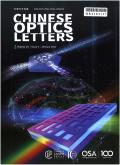Experimental realization of strong coupling between a cold atomic ensemble and an optical fiber microcavity
IF 2.8
2区 物理与天体物理
Q2 OPTICS
引用次数: 0
Abstract
Cavity quantum electrodynamics (QED) system is a promising platform for quantum optics and quantum information experiments. And its core is the strong coupling between atoms and optical cavity, which causes difficulty in the overlap for the atoms and the antinode of optical cavity mode. Here, we use a programmable movable optical dipole trap to load a cold atomic ensemble into an optical fiber microcavity and realize the strong coupling between the atoms and the optical cavity in which the coupling strength can be improved by polarization gradient cooling and adiabatic loading. By the measurement of vacuum Rabi splitting, the coupling strength can be as high as g N = 2 π × 400 MHz, which means the effective atom number is N ef f = 16 and the collective cooperativity is C N = 1466. These results show this experimental system can be used for cold atomic ensemble and cold molecule based cavity QED research.冷原子系综与光纤微腔强耦合的实验实现
空腔量子电动力学(QED)系统是一个很有前途的量子光学和量子信息实验平台。其核心是原子与光腔之间的强耦合,这使得原子与光腔模式的反极难以重叠。本文利用可编程移动光偶极阱将冷原子系综加载到光纤微腔中,实现了原子与光腔之间的强耦合,并通过极化梯度冷却和绝热加载提高了耦合强度。通过对真空拉比分裂的测量,耦合强度可高达g N = 2 π × 400 MHz,即有效原子序数N ef = 16,集体协同度C N = 1466。结果表明,该实验系统可用于冷原子系综和基于冷分子的腔QED研究。
本文章由计算机程序翻译,如有差异,请以英文原文为准。
求助全文
约1分钟内获得全文
求助全文
来源期刊

Chinese Optics Letters
物理-光学
CiteScore
5.60
自引率
20.00%
发文量
180
审稿时长
2.3 months
期刊介绍:
Chinese Optics Letters (COL) is an international journal aimed at the rapid dissemination of latest, important discoveries and inventions in all branches of optical science and technology. It is considered to be one of the most important journals in optics in China. It is collected by The Optical Society (OSA) Publishing Digital Library and also indexed by Science Citation Index (SCI), Engineering Index (EI), etc.
COL is distinguished by its short review period (~30 days) and publication period (~100 days).
With its debut in January 2003, COL is published monthly by Chinese Laser Press, and distributed by OSA outside of Chinese Mainland.
 求助内容:
求助内容: 应助结果提醒方式:
应助结果提醒方式:


